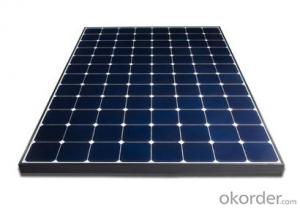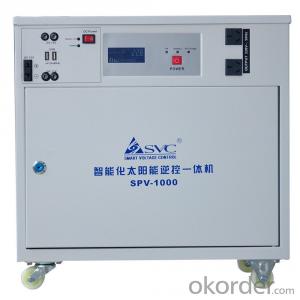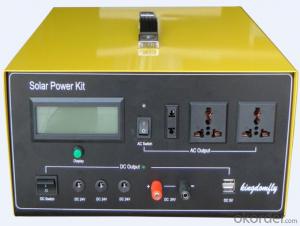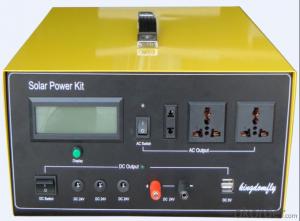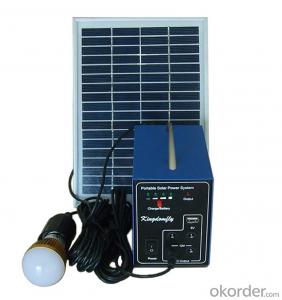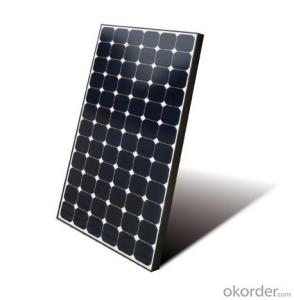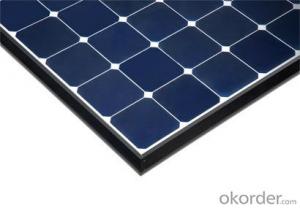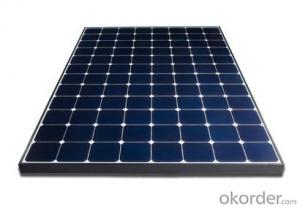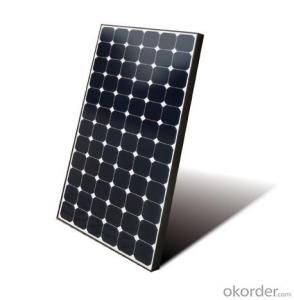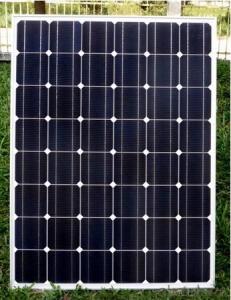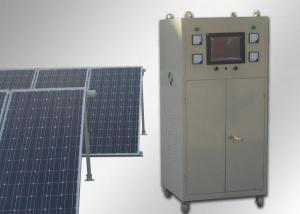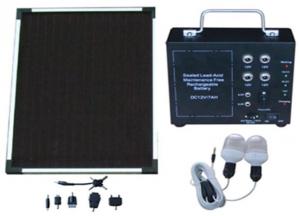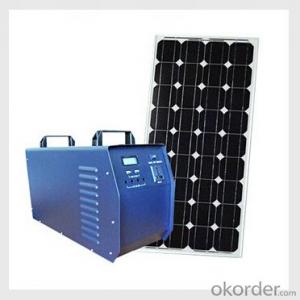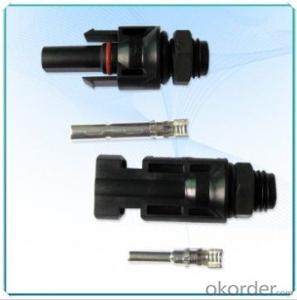Solar Energy Systems Nappanee Indiana - CNBM On Grid System 9000W with Certificate UL TUV CE
- Loading Port:
- Shanghai
- Payment Terms:
- TT OR LC
- Min Order Qty:
- 100 watt
- Supply Capability:
- 1000 watt/month
OKorder Service Pledge
OKorder Financial Service
You Might Also Like
Specification
CNBM On Grid System 9000W with Certificate UL TUV CE
Product description
They range from small residential and commercial rooftop systems to large utility-scale solar power stations. Unlike stand-alone power systems, a grid-connected system rarely includes an integrated battery solution, as they are still very expensive. When conditions are right, the grid-connected PV system supplies the excess power, beyond consumption by the connected load, to the utility grid.
Connection of the photovoltaic power system can be done only through an interconnection agreement between the consumer and the utility company. The agreement details the various safety standards to be followed during the connection.[4]
Electrical connections are made in series to achieve a desired output voltage and/or in parallel to provide a desired current capability. The conducting wires that take the current off the modules may contain silver, copper or other non-magnetic conductive [transition metals]. The cells must be connected electrically to one another and to the rest of the system. Externally, popular terrestrial usage photovoltaic modules use MC3 (older) or MC4 connectors to facilitate easy weatherproof connections to the rest of the system.
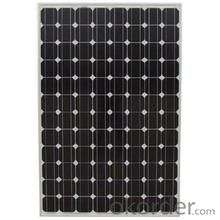
Application
Industrial
Commercial
Residential
Feature
Residential, grid-connected rooftop systems which have a capacity more than 10 kilowatts can meet the load of most consumers.[2] They can feed excess power to the grid where it is consumed by other users. The feedback is done through a meter to monitor power transferred. Photovoltaic wattage may be less than average consumption, in which case the consumer will continue to purchase grid energy, but a lesser amount than previously. If photovoltaic wattage substantially exceeds average consumption, the energy produced by the panels will be much in excess of the demand. In this case, the excess power can yield revenue by selling it to the grid. Depending on their agreement with their local grid energy company, the consumer only needs to pay the cost of electricity consumed less the value of electricity generated. This will be a negative number if more electricity is generated than consumed.[3] Additionally, in some cases, cash incentives are paid from the grid operator to the consumer.
Packaging
With carton and box
- Q: Can a solar energy system be installed in an area with high wind speeds?
- Yes, a solar energy system can be installed in an area with high wind speeds. However, it is essential to consider the wind load requirements and design the system accordingly to ensure its stability and durability in such conditions. This may involve using specialized mounting systems, robust materials, and proper anchoring methods to withstand the impact of strong winds and prevent any damage to the system.
- Q: I want to put on the roof of the solar system from the building, 100 square meters, daily consumption of 6 to 8 degrees. Some users know how much to install KM? About the cost?
- Now the national clean energy, photovoltaic power generation policy is more than 10kW can be free of charge, but the price of electricity recovery is very low, cumbersome procedures.
- Q: How is solar energy stored for later use?
- Various methods exist for storing solar energy for later use. One widely employed approach involves the utilization of solar batteries or energy storage systems. These batteries become charged during daylight hours, when excess solar energy is being generated. Subsequently, the stored energy can be utilized during periods of limited or no sunlight, such as nighttime or cloudy days. An alternative means of storing solar energy is through the adoption of thermal energy storage systems. These systems convert solar energy into thermal energy, which is then stored in a medium like water or molten salt. This stored thermal energy can subsequently be utilized to produce electricity or heat whenever necessary. Moreover, solar energy can be indirectly stored through the utilization of pumped hydroelectric storage. Excess solar energy is employed to pump water from a lower reservoir to a higher one. When electricity is required, the stored water is released and flows down to a lower reservoir, generating electricity via turbines. In addition, solar energy can also be stored in the form of compressed air. Excess solar energy is utilized to compress air into storage containers. When electricity is needed, the compressed air is released and expanded through turbines, generating electricity. In conclusion, the storage of solar energy for future use plays a critical role in ensuring a consistent and uninterrupted power supply. These storage methods enable us to maximize the advantages of solar energy and overcome the challenges posed by its intermittent availability.
- Q: How do solar energy systems impact the reduction of fossil fuel consumption?
- The reduction of fossil fuel consumption is greatly influenced by solar energy systems. One of the key benefits of solar energy is its utilization of the sun's power, which is a renewable energy source. This implies that solar energy systems do not rely on the burning of fossil fuels like coal or natural gas to generate electricity. By adopting solar energy, we can decrease our dependence on fossil fuels for electricity generation, thereby reducing our carbon footprint and addressing the negative environmental consequences associated with fossil fuel consumption. Additionally, solar energy systems contribute to the reduction of fossil fuel consumption through net metering. Net metering allows individuals or businesses with solar panels to sell any excess electricity generated back to the grid. This means that when solar energy production is high and exceeds the amount being used, the surplus energy is fed into the grid. Consequently, the need for fossil fuel-based power plants to produce electricity to meet demand decreases, resulting in an overall reduction in fossil fuel consumption. Moreover, the adoption of solar energy systems can lead to a decrease in the demand for fossil fuel-based electricity, which can subsequently drive down electricity prices. This price reduction enhances the economic competitiveness of renewable energy, encouraging greater adoption of solar energy systems and further decreasing the demand for fossil fuels. In conclusion, solar energy systems play a crucial role in reducing fossil fuel consumption. By harnessing the sun's energy, solar power systems eliminate the necessity of burning fossil fuels for electricity generation. Through net metering and the potential for price reductions, solar energy systems contribute to the overall reduction of fossil fuel consumption, promoting a cleaner and more sustainable energy future.
- Q: Are there any limitations to installing a solar energy system in a homeowner's association?
- There are potential limitations to installing a solar energy system in a homeowner's association (HOA). Although some HOAs have embraced renewable energy and implemented guidelines to facilitate solar installations, others may have restrictions or limitations. One possible limitation is the HOA's adherence to specific aesthetic guidelines or architectural standards. This means that the solar panels must be installed in a manner that aligns with the overall design and appearance of the community. In certain instances, this could result in limitations on the panels' size, location, or visibility. Another limitation is the impact on property values. While solar energy systems are generally viewed as a desirable feature, certain homeowners may have concerns regarding their effect on property values. Consequently, the HOA may require an approval process, including a review conducted by a committee or board, before permitting installation. Furthermore, limitations may exist related to the structural integrity of the property. The weight of solar panels can be substantial, and certain roofs or structures may not be able to handle the additional load. To ensure that the installation will not compromise the building's integrity, the HOA may demand a structural assessment or engineering report. Lastly, limitations may arise from legal and regulatory requirements. Depending on the jurisdiction, specific permits, licenses, or agreements may be necessary for solar installations. The HOA may be responsible for obtaining all required documentation and approvals, which can complicate and prolong the installation process. In summary, it is essential for homeowners to carefully review their specific HOA guidelines and engage in open communication with the association in order to understand any limitations or requirements that may be in effect.
- Q: Can solar energy systems be used in powering wastewater treatment plants?
- Yes, solar energy systems can be used to power wastewater treatment plants. Solar panels can be installed to generate electricity, which can be used to power various components of the treatment plant such as pumps, blowers, and lighting. This renewable energy source reduces the reliance on traditional fossil fuels, lowers operating costs, and helps to reduce the carbon footprint of wastewater treatment facilities.
- Q: Can a solar energy system be integrated with energy storage systems?
- Yes, a solar energy system can be integrated with energy storage systems. In fact, this integration is becoming increasingly popular and important in the renewable energy sector. Energy storage systems, such as batteries, allow excess energy generated by solar panels to be stored for later use when the sun is not shining or during periods of high demand. This helps to address the intermittent nature of solar energy production and ensures a more reliable and continuous power supply. By combining solar energy systems with energy storage, users can reduce their reliance on the grid, increase self-consumption of solar energy, and even achieve complete energy independence in some cases. Moreover, this integration is crucial for the advancement of sustainable and resilient energy systems, as it enables the integration of renewable energy sources into the grid and smooths out fluctuations in energy supply and demand.
- Q: How do solar energy systems affect the reliability of electricity supply?
- Solar energy systems can enhance the reliability of electricity supply by diversifying the energy sources and reducing dependence on traditional power grids. With solar panels generating electricity directly from sunlight, these systems can provide a stable and consistent power supply, especially during daylight hours. Additionally, when integrated with battery storage, solar energy systems can store excess energy for use during nighttime or periods of low sunlight, further improving reliability.
- Q: Can solar energy systems be used for powering transportation infrastructure?
- Solar energy systems have the ability to power transportation infrastructure. By utilizing photovoltaic panels, solar energy can be converted into electricity, which can then be used to fuel electric vehicles or stored in batteries for future use. This approach can have particular advantages for public transportation systems, such as buses and trains, as well as personal vehicles. To facilitate the charging of electric vehicles using clean and renewable energy, solar-powered charging stations can be installed along highways or in parking lots. Furthermore, solar energy can be harnessed to power traffic lights, streetlights, and other infrastructure elements, thereby reducing dependence on fossil fuels and decreasing greenhouse gas emissions. In conclusion, the integration of solar energy into transportation infrastructure paves the way for a more sustainable and environmentally friendly transportation system.
- Q: Can a solar energy system be installed on a parking garage or structure?
- Certainly, it is entirely possible to install a solar energy system on a parking garage or structure. As a matter of fact, these locations are often considered ideal for solar installations due to their expansive surface areas and access to sunlight. The utilization of available space can be maximized by mounting solar panels on the roof or external walls of parking structures. Furthermore, the raised position of parking garages enables better exposure to sunlight, resulting in more efficient generation of solar energy. Furthermore, the installation of a solar energy system on a parking garage or structure can yield numerous advantages, including the generation of clean and renewable energy, reduction in electricity costs, and offsetting of carbon emissions. This choice therefore proves to be a sustainable and environmentally friendly option for energy production.
Send your message to us
Solar Energy Systems Nappanee Indiana - CNBM On Grid System 9000W with Certificate UL TUV CE
- Loading Port:
- Shanghai
- Payment Terms:
- TT OR LC
- Min Order Qty:
- 100 watt
- Supply Capability:
- 1000 watt/month
OKorder Service Pledge
OKorder Financial Service
Similar products
Hot products
Hot Searches
Related keywords
